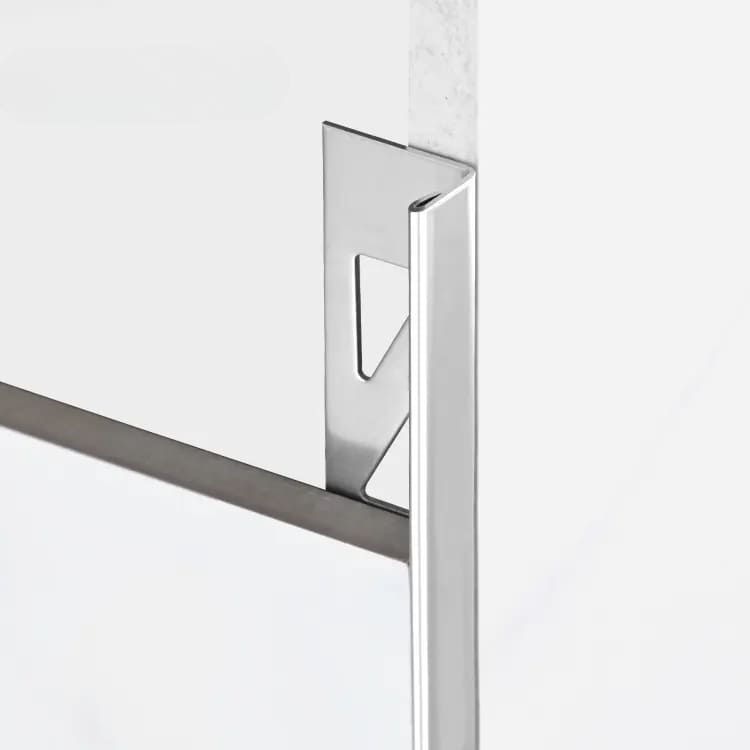Tile trim is a familiar term to those involved in the construction and engineering industry. But do you know how many types of tile trim exist?
In this article, you will find comprehensive information about tile trim. Now, let's delve deeper to understand what tile trim is and explore its features, classified by different applications.
What is Tile Trim?
Tile trim, also known as a tile edge trim or tile profile, is a finishing edge positioned along the borders of a tile field during installation. Bonded beneath the tile with an anchoring leg, the profile is set into the same thin-set mortar as the tile, becoming a permanent part of the assembly.

The Main 2 Reasons to Use Tile Trims
1. Protection
One of the main purposes of tile trims is to protect the edges of tiles from damage. Tiles, especially those with cut edges, are vulnerable to chipping, cracking, or breaking. Tile trims act as a barrier, safeguarding these edges from physical impact, which is important in high-traffic areas like floors and kitchen countertops. This protection helps enhance the longevity of the tile installation by reducing wear and tear over time.
2. Aesthetic
Tile trims significantly contribute to the overall appearance of a tiled area. They provide a neat, clean, and polished look by creating crisp lines and transitions between the tile surface and adjacent materials or spaces. Available in various materials, colors, finishes, and shapes, tile trims offer numerous design options, allowing for personalization and a high-end designer effect. Whether used to create a contrasting finish or to blend into the tile field, trims enhance the visual appeal of the installation.
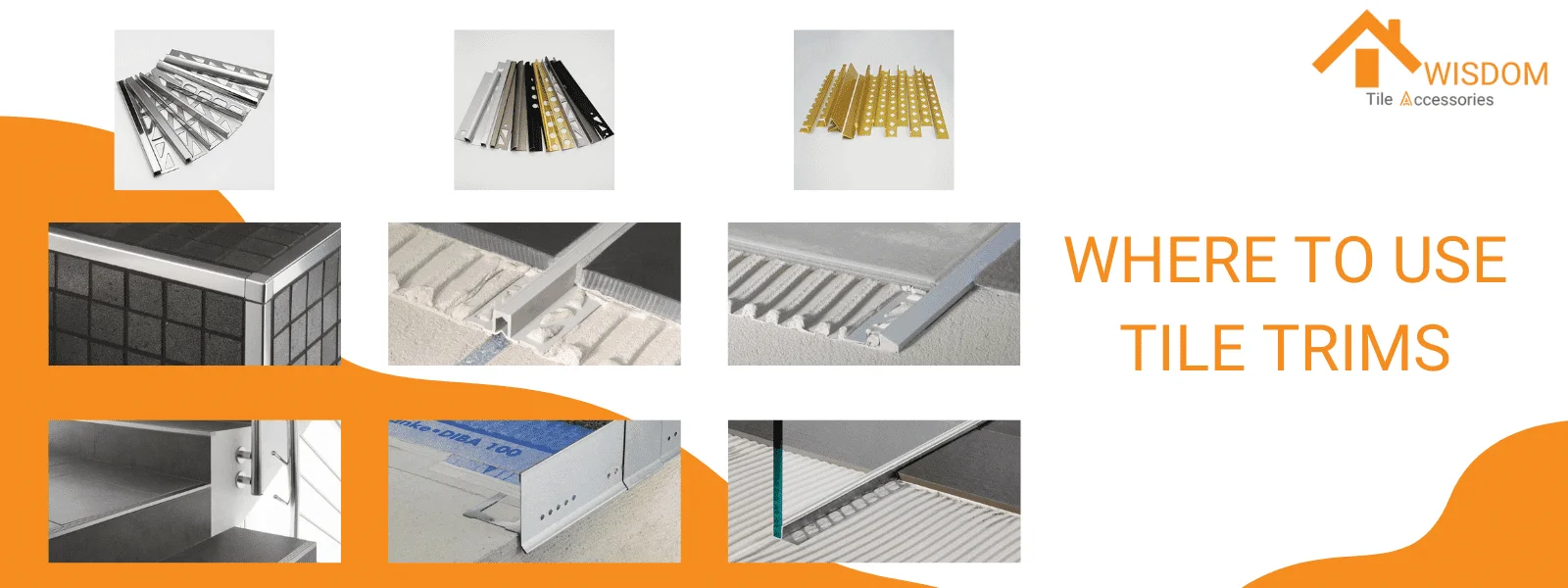
Form 1: Things to know when buying tile edge trims
Tile Trim Type | Description | Key Features | Application Areas |
|---|---|---|---|
Angle Trim | L-shaped profiles for protecting tile edges and creating decorative transitions. | Prevents chipping, enhances aesthetics. | Walls, floors, backsplashes, bathtub surrounds. |
Flexible Angle Trim | Bending variant of Angle Profiles, offering flexibility for curved transitions and edge protection. | Curved decorative lines, transitions between tile and other flooring materials. | Floors, doorways, transitions. |
Round Edge Trim | Modern square edge trim for vertical and horizontal tile edges, alternative to angle profiles. | Rounded trim, protects tile edges. | Corners, curved installations. |
Square Edge Trim | Quarter round profiles that provide a rounded edge trim, reducing mechanical strains between tiles. | Contemporary look, various textures and materials. | Wall edges, floors, interior and external corners. |
U Edge Trim | U-shaped profiles for creating smooth transitions and reducing installation challenges. | Horizontal tile transition, contrasts with tile colors. | Floor and countertop applications. |
T Edge Trim | T-shaped profiles for seamless transitions between different materials and expansion joints. | Elegant look, covers joints effectively. | Floors, walls, expansion joints. |
Corner Protection Trim | Corner protectors that absorb impact and provide a clean look at tile corners. | Minimalist appearance, easy installation. | Protecting exposed corners, damaged walls. |
Coving Profiles | Floor coving profiles for maintaining hygiene and creating tidy transitions in corners and wall intersections. | Prevents surface water infiltration, hygienic applications. | Food hygiene areas, healthcare settings. |
LED Trim | Profiles integrating LED lighting for decorative and functional purposes on tiled surfaces. | Illuminates floors, walls, staircases. | Residential, commercial interiors. |
Application of Tile Trims
For Floor
- Same High Transition: Tile trims are used around the edges of tiled floors to protect the tiles from damage and create a seamless transition to adjacent flooring materials like carpet or wood.
- Sloped Transition: Trims are used at doorways and other transitions between different flooring types to ensure a smooth and safe transition.
For Wall
- Corners and Edges: Tile trims are used to finish the exposed edges of wall tiles, such as in bathrooms and kitchens. They prevent chipping and create a clean, professional look.
- Backsplashes: Trims provide a neat finish to kitchen backsplashes, ensuring that the edges are smooth and protected from moisture.
- Shower Niches and Benches: Trims are used to finish the edges of shower niches and benches, providing a waterproof barrier and a polished appearance.
Different Types of Tile Trims
Tile trims are primarily crafted from various metals, such as stainless steel, brass, and aluminum alloy. Additionally, PVC options are available in the market. These trims are categorized based on their specific applications and distinct shapes.

Aluminum Tile Trim
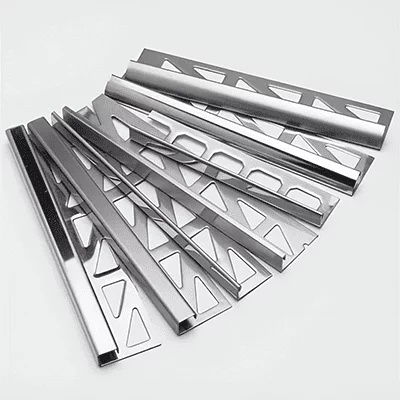
Stainless Steel Tile Trim

Brass Tile Trim
1. Angle Profiles (L-Shaped Tile Trim)
Angle Profiles, also known as L-Shaped Edge Trim Profiles, are used for slope end profiles on walls and floors and were designed expressly to preserve tile edges.

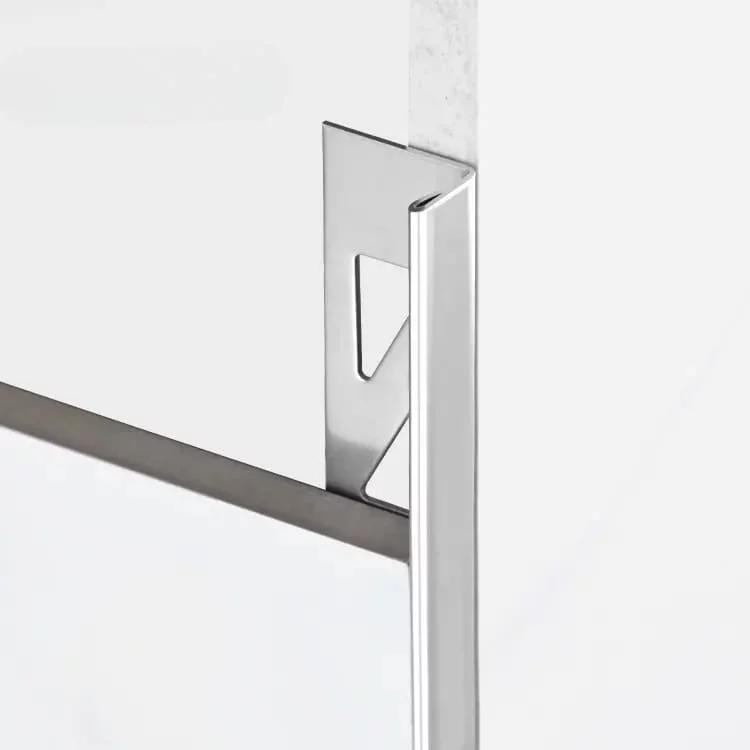
- Prevents tile edges from chipping.
- Creates decorative transitions on floors or walls.
- Decorates top edges of tiled walls, backsplashes, and bathtub surrounds.
2. Flexible Angle Profiles
A bending variant of Angle Profiles with excellent flexibility. Designed for curving transition decorations that match the form and curves of the flooring or wall covering. It also effectively protects tile edges.

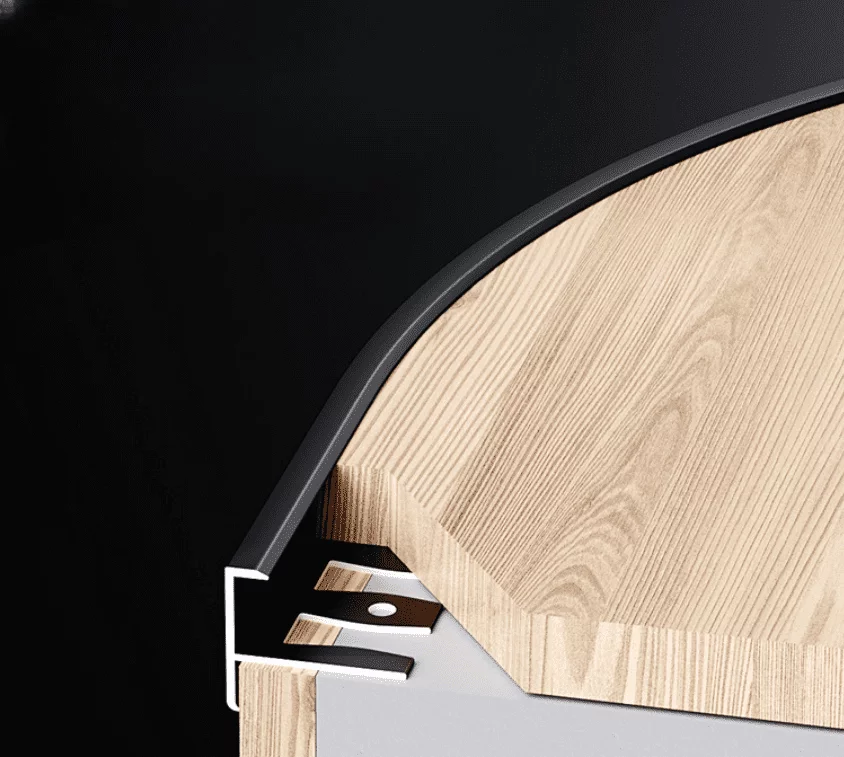
- Creates curved decorative lines for floors.
- Easily transitions from tile to carpet or other coverings.
- Radius perforations in anchoring legs enhance flexibility.
3. Round Profiles (Round Edge Tile Trim)
Round Profiles, sometimes called Quarter Round Profiles or Round Edge Tile Trims, are typically utilised with corner pieces. Provides a distinctive rounded edge trim while protecting tile.

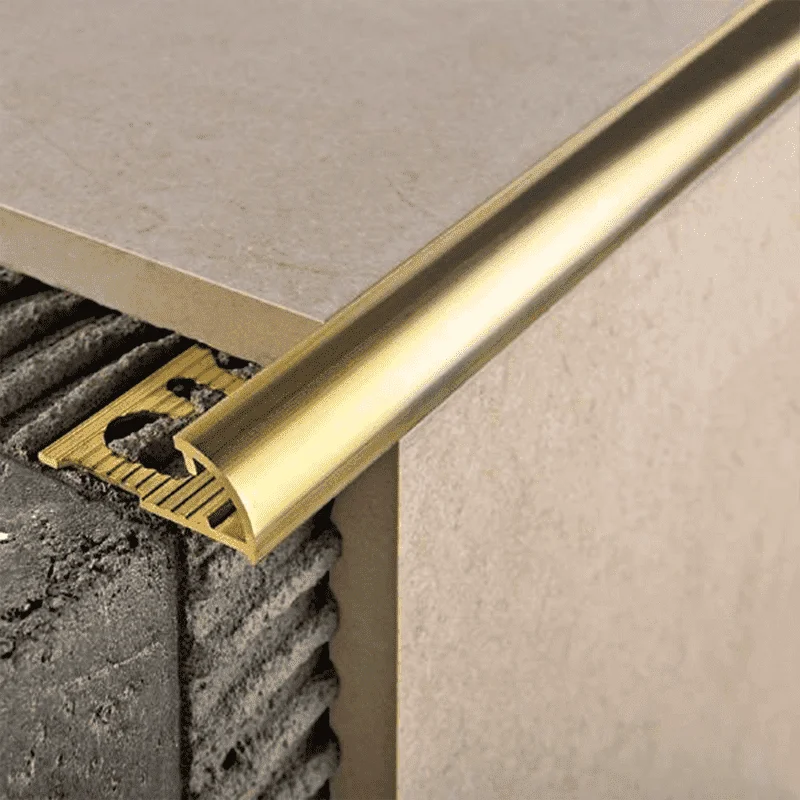
- Quarter rounds are available in fully open, semi-closed and closed designs
- Reduces mechanical strains between tiles.
4. Square Profiles (Square Edge Tile Trim)
This square tile trim can be used for vertical tile edge trim on walls or edge trim on floor tiles, and it is a great alternative to straight edge or angle profiles. It is frequently used with interior and external corners to prevent sharp edges when mitered connections are required.

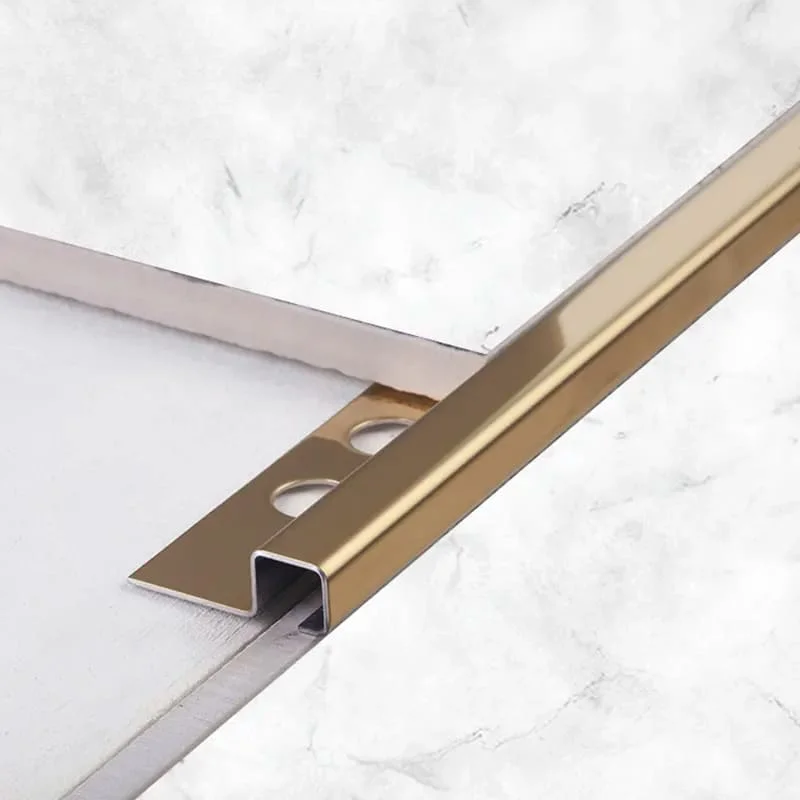
- Offers a modern square edge look.
- Available in several surface textures and materials.
5. U-Profiles (U-Shaped Tile Trim)
U-Profiles, also known as Listello Tile Trim, are flat decorative profiles that protect tile edges while ensuring a smooth transition.

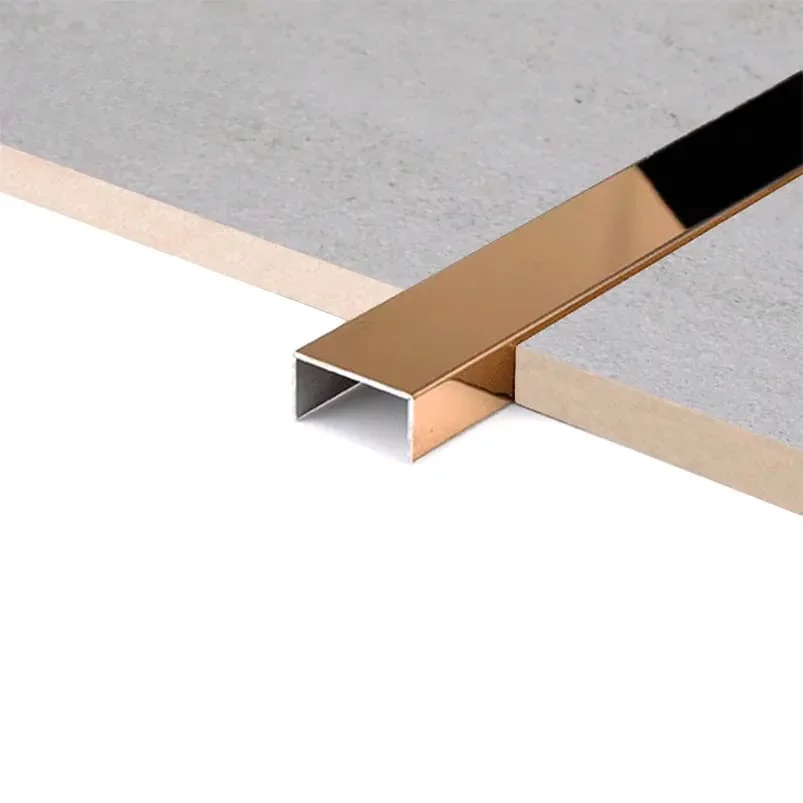
- U-shaped construction reduces installation difficulties.
- Horizontal tile transition effectively avoids tripping.
- Can be used to create a bright contrast with tile colours
6. T-Profiles (T-Shaped Tile Trim)
T-Profiles, sometimes referred to as T-Shaped Transition Strips, are used to separate and cover spaces between different materials or expansion joints. For the transition of surface coverings that are the same height, it is a great solution.


- Ideal for transitions between different materials on floors or walls
- Covers joints well and provides an elegant look
- Prevents damage to tile edges
7. Corner Protection Profiles
These corner protection profiles, also known as Edge Protectors, protect tile surfaces and tile edges by absorbing impact from the outside corners of walls. In terms of appearance, these tile trims provide a clean and minimalist look.

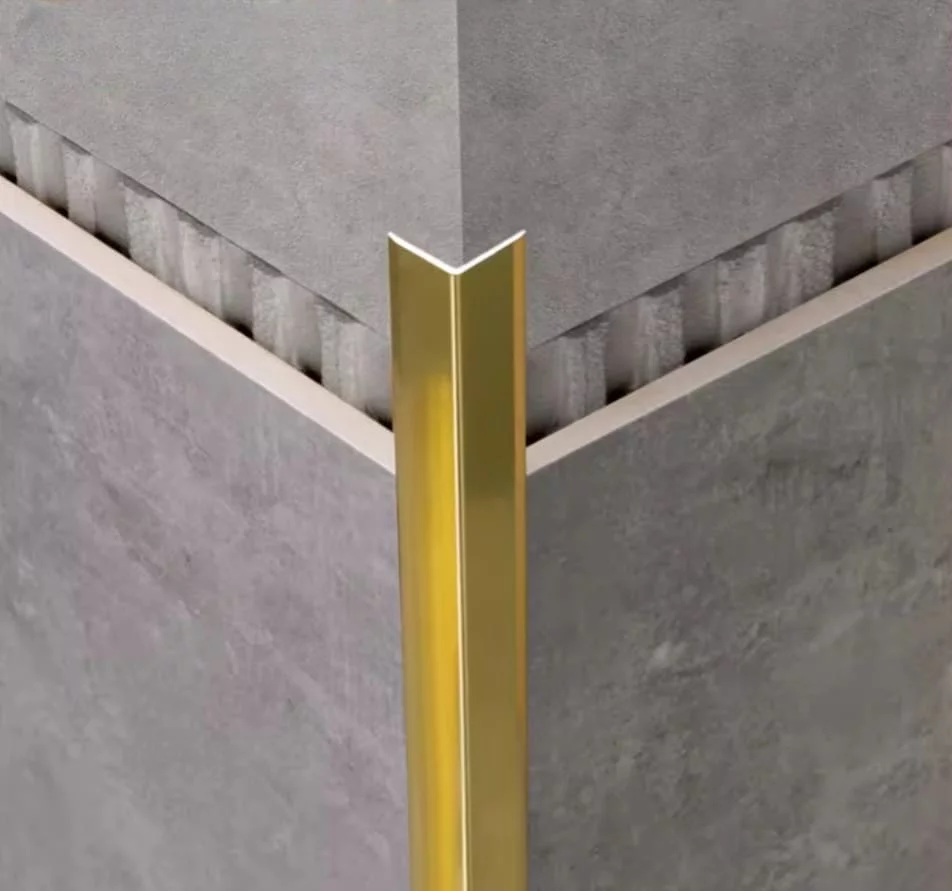
- Easy installation with self-adhesive strips
- Can cover up damaged walls, eliminating the cost of repair.
8. Coving Profiles
Coving Profiles, also known as floor coving or internal corner tile trim, are a visually appealing and tidy alternative to internal corners and wall transitions. It is frequently used in tandem with internal and external corners and end caps. In construction applications, it helps to maintain environmental hygiene, particularly in food hygiene and healthcare.

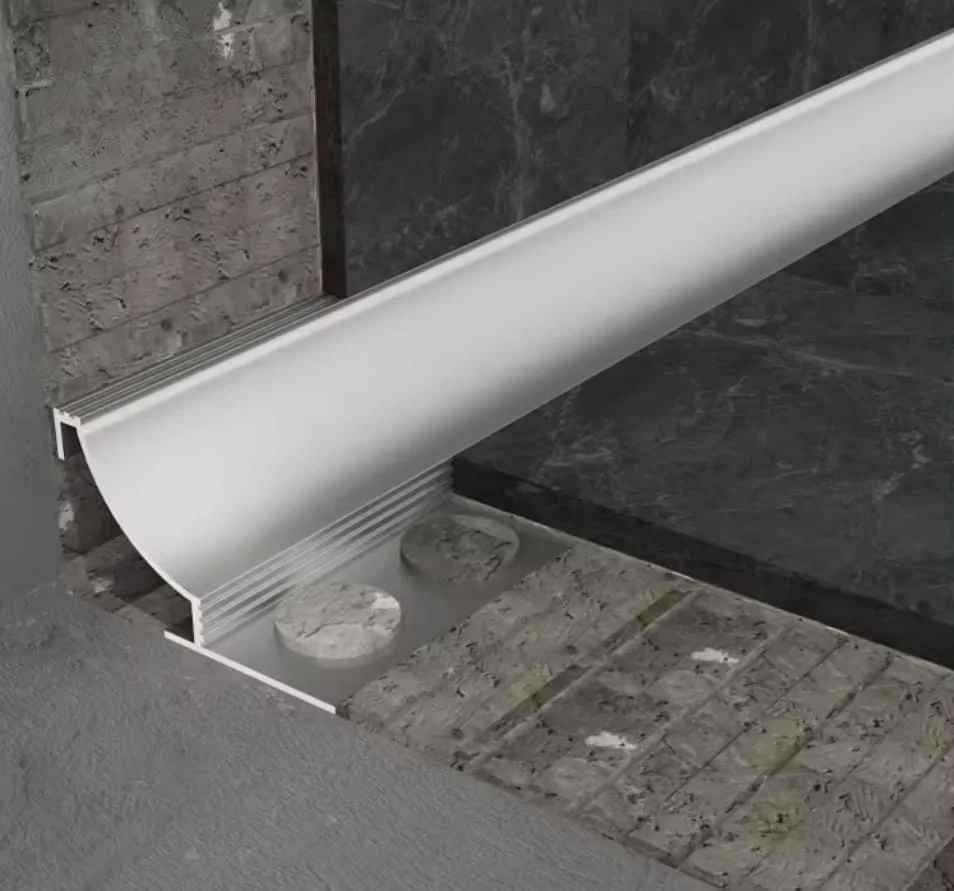
- Also suitable for floor and countertop applications.
- Prevents infiltration of surface water.
- Prevents dirt build-up.
9. Transition Profiles
Transition profiles, also known as adjustable height profiles or triangle tile trims, are fitted and secured to the mortar bonding layer beneath the tiles. It offers a practical solution for bridging gaps and height disparities between floor finishes, allowing a smooth transition between floor coverings of different height.
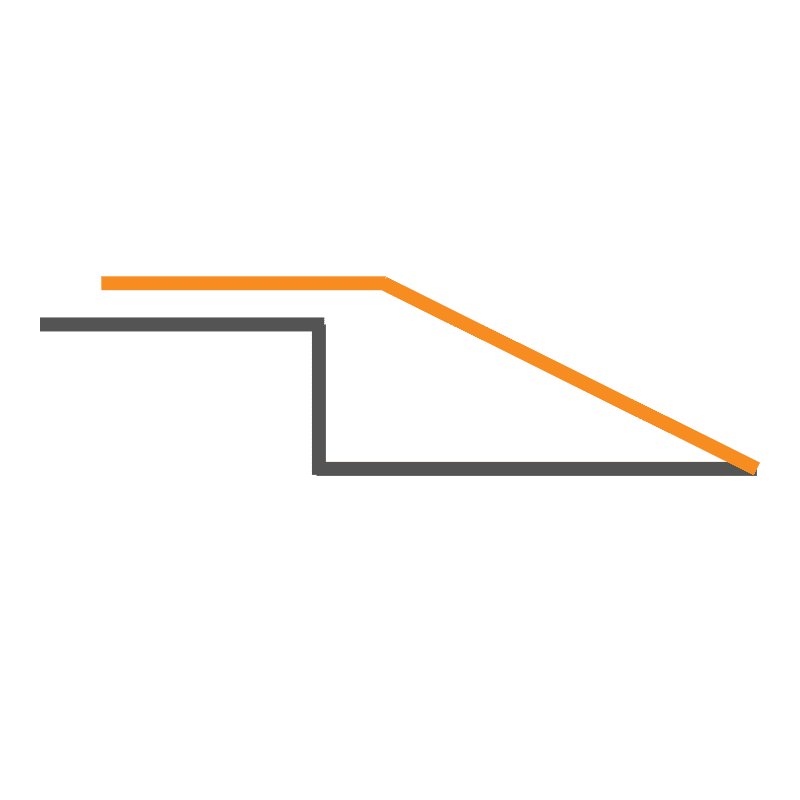

- Available in self-adhesive clauses that do not require screw fixing.
- Protects tiles between different heights.
- Removes tripping hazards with smooth transitions.
10. LED Profiles (LED Tile Trim)
LED profiles, unlike other tile profiles, are intended to preserve tile edges while also serving as an interior lighting option. It may be applied to surfaces such as walls, floors, ceilings, and staircases, making it an ideal modern profile design.


- Suitable for all commercially available LED strips.
- Available in 3000k, 4000k and 6000k color temperatures.
- Creates a sparkling effect on tiled floors or walls.
11. Slope Profiles (Shawdow Gap)
Slope profiles, also known as shower profiles, are made up of glass walls in recessed showers and wedge-shaped slope trim, making them the perfect solutions for barrier-free showering.
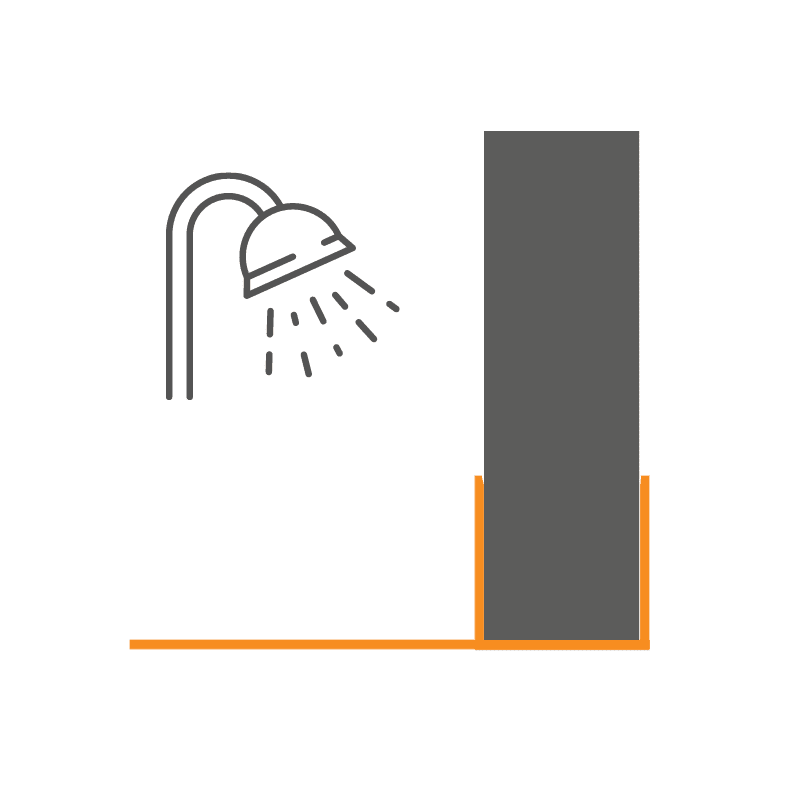
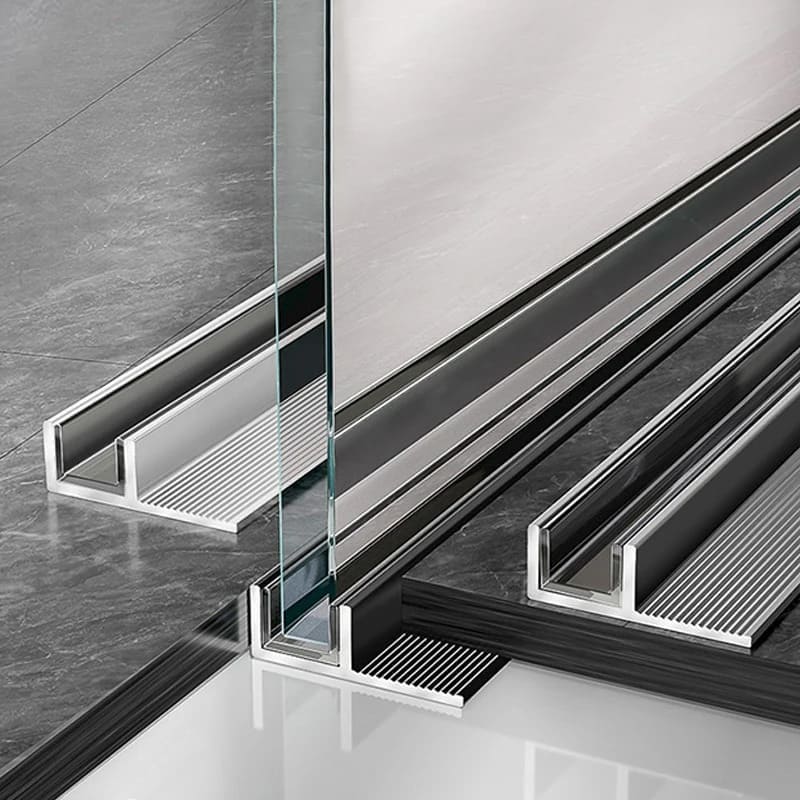
- Suitable for vertical support of glass walls.
- Can be used for transitions to walls or adjacent floors.
- Excellent water resistance.
12. Balcony Profiles (Balcony Tile Trim)
A special profile for balcony edges comprising a drainage solution. The top of the profile has a vertical wall section that protects tiles from damage and also covers unsightly or broken tile edges.
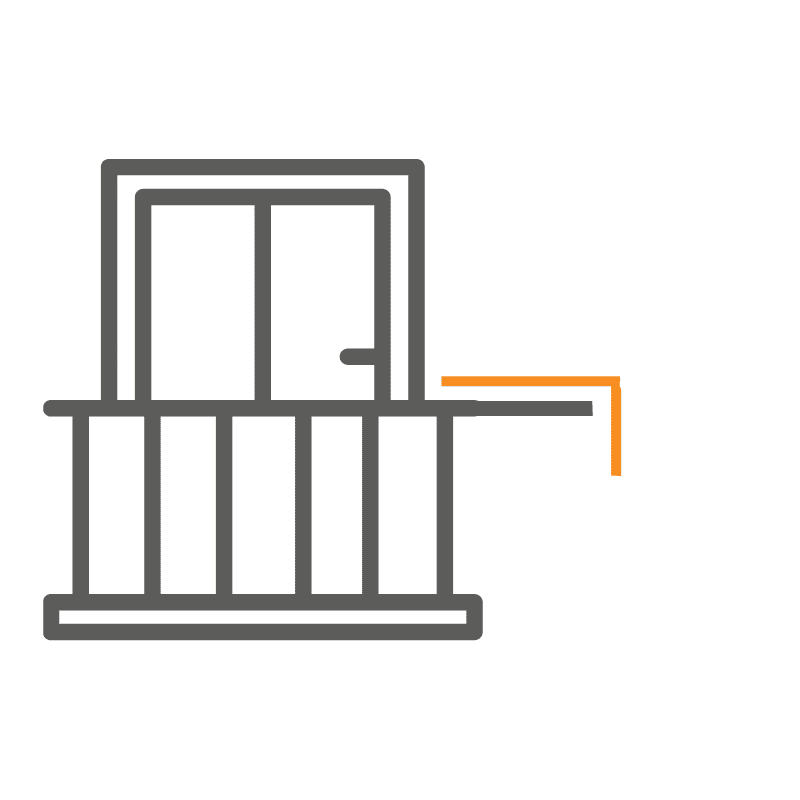
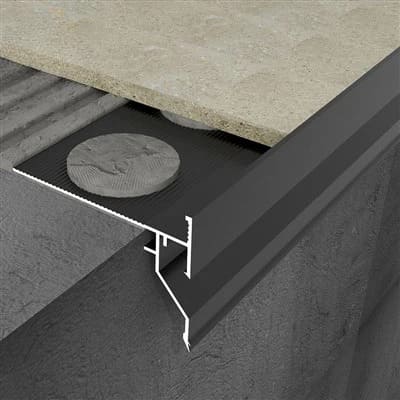
- Allow the rainwater to drain off nicely, preventing any water from pooling.
- Keeping the edges of the tiles protected from the sun or rain.
13. Stair Profiles
It is also known as stair nosing and serves to protect the edges of tiles on stair surfaces. Not only is it decorative, it also increases the visibility of the steps and reduces the chance of slipping.

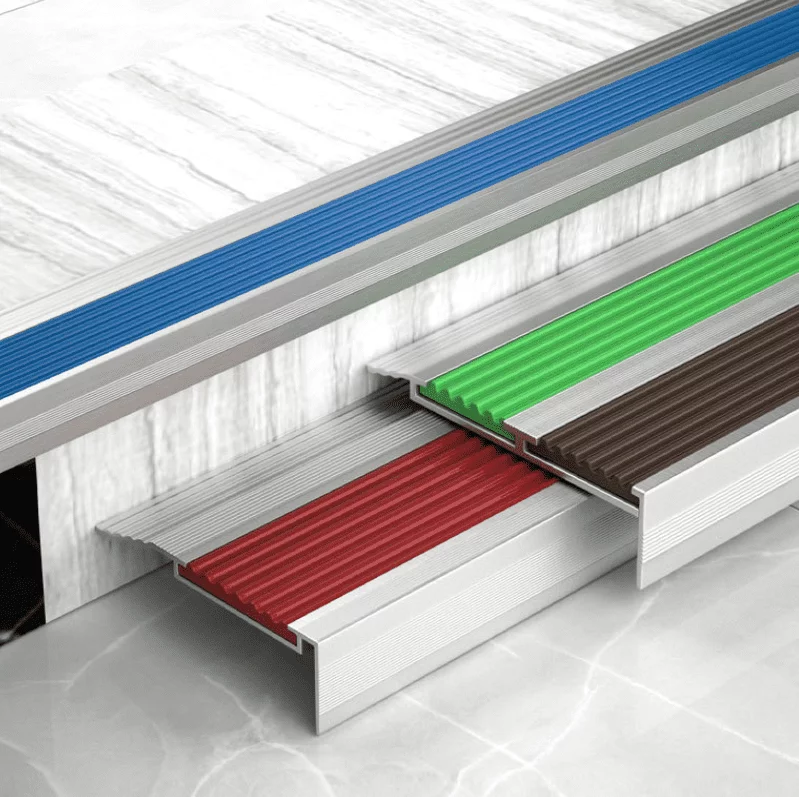
- Prevent wear and tear on tiles on stairs.
- Anti-slip adhesive strips are effective in increasing friction.
- Carborundum strips maximise safety.
- LED strips provide a lighting solution for stairs.
14. Skirting Boards
Skirting board, often known as baseborad, is a profile used to transition from floor coverings to tiled walls. It protects the inside corners of floor or wall tiles, preventing dust, filth, and buildup. To meet modern design requirements, metal skirting boards are available in a greater selection of styles and finishes than traditional wood skirting boards.


- Available in both aluminium and stainless steel.
- Equipped with inside corners, outside corners and end caps for easy installation.
- LED lighting options are available for illumination at the base of the wall.
15. Expansion Joint Profiles
Expansion Joint profiles, also known as movement joints, safeguard tile edges by preventing stress cracks induced by material expansion. Hospitals, shopping malls, and offices are among the potential applications.

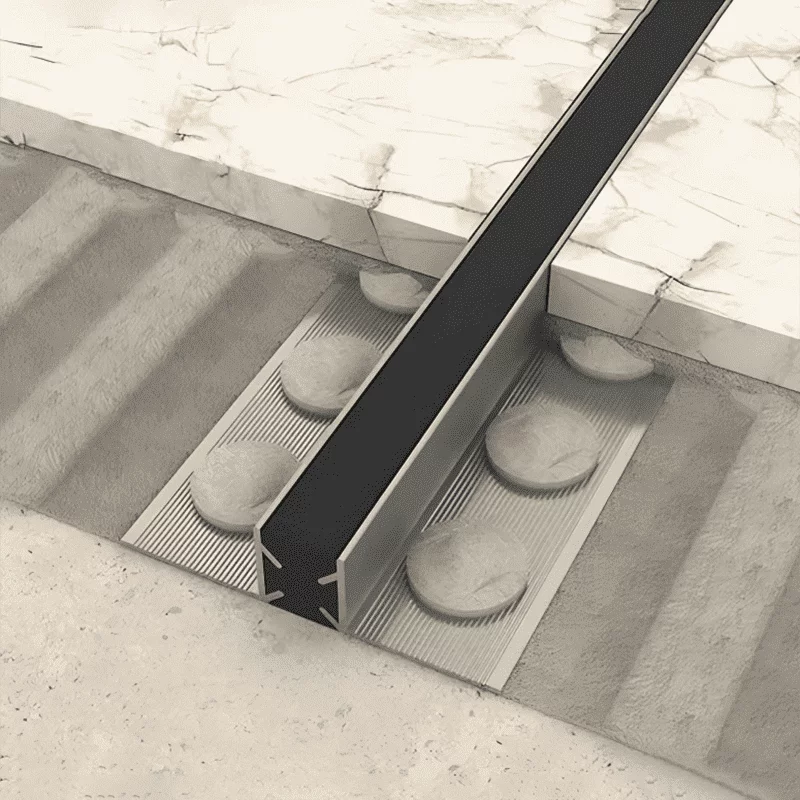
- Reduces stress on large tile areas.
- Prevents internal cracking and delamination of tiles.
Your Reliable Tile Trims One-Stop Solution Supplier In China
At Awisdom Tile Accessories, we are dedicated to providing global clients with superior tile trim solutions and related products. With over twenty years of industry leadership, our expertise in manufacturing and supply positions us as a pivotal resource for your business needs.

Why Partner with Awisdom Tile Accessories?
>> See How to Avoid Taxes When Importing Aluminum from China to UK
Engage with Us
To discuss how we can support your business with our innovative and cost-effective tile trim solutions, please contact Awisdom Tile Accessories. Our team is ready to provide you with detailed information and personalized service tailored to your market.
Discover how our commitment to excellence can contribute to your success.
>> See Our Tile Trim Series
>> See Our Company Profile
FAQs About Tile Trims
Is tile trim necessary?
Tile trim is not strictly necessary, but it is highly recommended for several reasons. It provides a finished look to tile installations, protects the edges from chipping, and creates a clean, professional appearance. Additionally, tile trim helps cover up any rough edges that could become hazardous over time, ensuring a safer environment in any tiled area.
How should I choose the right tile trim?
Choosing the right tile trim depends on the application and design requirements. Consider the specific areas where the tile will be installed, such as bathrooms, rooms, floors, and walls. Each setting might require different types of trim based on exposure to moisture, foot traffic, and aesthetic considerations. If you're unsure which type of tile trim suits your project, feel free to contact us for a comprehensive solution tailored to your needs.
What is the best material for tile trim?
The best material for tile trim depends on the specific application:
- Stainless Steel: Extremely durable, ideal for high-traffic areas and external corners.
- Aluminum: Rust-resistant and eco-friendly, suitable for wet areas like bathrooms and showers, and for projects with environmental sustainability considerations.
- Brass: Offers a timeless and luxurious appearance, perfectly complementing warm tones and traditional designs.
- PVC: Appropriate for light applications and when budget constraints are present, providing an economical choice.
How should I install tile trim correctly?
To correctly install tile trim, such as the L-Shaped Tile Trim (Angle Profile), follow these essential steps:
- Embed the Profile: Ensure the tile trim is embedded in thinbed mortar, with mortar applied both below and above the profile. This supports the tile and prevents cracking.
- Trowel Mortar Uniformly: Trowel the mortar in one direction on the base surface before placing the trim.
- Apply Additional Mortar: Add more mortar using a notched trowel in the same direction or back butter the edge of the tile that will adjoin the trim.
- Ensure Full Coverage: After placing the tile, move it back and forth perpendicularly to the mortar lines to collapse the ridges for complete coverage.
These steps are specific to installing L edge profiles but generally are also applicable to other types of tile trim.
Can I import tile trim from China?
Yes, you can absolutely import tile trim from China. With its leading global manufacturing capabilities, China offers high-quality products at lower prices along with top-notch transportation services. Importing from China can be a cost-effective way to source tile trim for any scale of project.
Is there any customs duty for importing tile trim from China?
Customs duty for importing tile trim from China depends on the regulations of the destination country. It is advisable to consult local customs authorities or a customs broker to understand applicable duties and tax rates. Alternatively, you can contact us for a one-stop import solution tailored to the regulations of your country, as our professional team is well-equipped to assist with the import process.
How long is the shipping time for importing tile trim from China?
The shipping time for importing tile trim from China varies depending on the mode of transport and the destination. Generally, air freight takes a few days, while sea freight can take several weeks. If you need a specific estimate, feel free to consult with us. We can provide a more accurate timeframe based on the information you provide and our extensive experience in international shipping.
>> See Ultimate Guide: Import Shipping from China to Philippines



